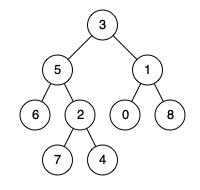Given the root of a binary tree, return the lowest common ancestor
(LCA) of two given nodes, p and q. If either
node p or q does not exist in the tree,
return null. All values of the nodes in the tree are
unique.
According to the definition
of LCA on Wikipedia: "The lowest common ancestor of two nodes
p and q in a binary tree T is the lowest node
that has both p and q as descendants
(where we allow a node to be a descendant of itself)". A
descendant of a node x is a node y that
is on the path from node x to some leaf node.
Example 1:

Input: root = [3,5,1,6,2,0,8,null,null,7,4], p = 5, q = 1 Output: 3 Explanation: The LCA of nodes 5 and 1 is 3.
Example 2:

Input: root = [3,5,1,6,2,0,8,null,null,7,4], p = 5, q = 4 Output: 5 Explanation: The LCA of nodes 5 and 4 is 5. A node can be a descendant of itself according to the definition of LCA.
Example 3:

Input: root = [3,5,1,6,2,0,8,null,null,7,4], p = 5, q = 10 Output: null Explanation: Node 10 does not exist in the tree, so return null.
Constraints:
- The number of nodes in the tree is in the range
[1, 104]. -109 <= Node.val <= 109- All
Node.valare unique. p != q
Follow up: Can you find the LCA traversing the tree, without checking nodes existence?
Difficulty:
MediumLock:
PrimeProblem Solution
1644-Lowest-Common-Ancestor-of-a-Binary-Tree-IIAll Problems:
Link to All Problems
All contents and pictures on this website come from the Internet and are updated regularly every week. They are for personal study and research only, and should not be used for commercial purposes. Thank you for your cooperation.